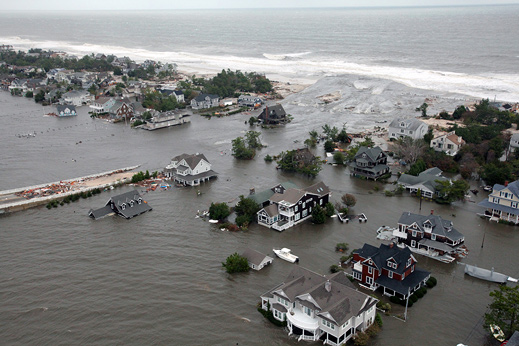Solving Global Warming Will Require Far Greater Cuts than Thought
Carbon dioxide emissions need to be reduced far more and far faster than previously thought if a global temperature rise is to be kept under 2 °C, according to a report in Environmental Research Letters. The researchers say that scaling up existing technology won’t be good enough to meet the goals. Instead, we need new technological breakthroughs.

A landmark scientific paper published in 2004 concluded that for the next 50 years, climate change could be controlled “simply by scaling up what we know how to do.” That paper, co-authored by Robert Socolow, a professor of mechanical and aerospace engineering at Princeton University, broke the climate change problem into manageable “wedges,” suggesting 15 things that could be done—such as doubling the number of nuclear reactors, building a million wind turbines, or reversing tropical deforestation—each of which would reduce the rate of carbon dioxide emissions by a gigaton of carbon per year when fully deployed.
The 2004 paper concluded that to address climate change, all that’s needed for the next 50 years is to deploy seven of these wedges, which would keep emission rates flat even as global energy use rises. By that time, new technology could make it possible to start decreasing emissions, eventually reaching zero within another 50 years. This approach would keep concentrations of carbon dioxide in the atmosphere below 500 parts per million, a level thought to avoid the worst impacts of climate change.
The new report suggests that achieving the goal of keeping a global temperature increase below 2 °C—a commonly agreed upon international goal—will actually require as many as 31 wedges, or 31 fewer gigatons of carbon per year than would be emitted if nothing were done. And it says that new technology breakthroughs will be needed sooner than expected in order to achieve the goals. Martin Hoffert, an emeritus professor of physics at New York University and one of the authors of the study, says, “If you look at it objectively, you’re looking into the abyss.”
In the new paper, the researchers give several reasons for the far higher numbers. The simplest reason is that in the years since the report, the rate of emissions has already gone up from seven gigatons of carbon dioxide a year to almost 10 gigatons a year. But the authors of the new paper also argue that keeping emission rates flat for 50 years is no longer compatible with keeping carbon dioxide levels below 500 parts per million. Stabilizing at the current, higher rate will lead to levels over 500 parts per million by 2049.
To keep temperature increases below 2 °C, the authors of the new paper argue, the carbon emissions rate needs to drop to zero by about 2060. And doing that would require employing 10 additional wedges, bringing the total to 19. They base their analysis on a recent climate model—but acknowledge that those remain uncertain. While climate scientists are confident about the link between carbon dioxide levels and rising temperatures, no one knows for sure just how much the planet will warm for a given amount of carbon dioxide.
The researchers go on to point out that the 2004 paper was based in part on incorrect assumptions about the carbon intensity of world economies. It assumed that the amount of emissions per GDP would go down somewhat, as it had been historically, without employing any additional efforts. But in the intervening years, the economies of places such as India and China have grown quickly, and with them, the use of high carbon coal for power generation.
To give a sense of the extreme measures that might be needed, Hoffert says, it might be necessary to put solar panels in space, where they can be exposed to the sun around the clock, and then beaming the power to earth with lasers or microwaves. Also on his wish list: global superconducting power grids for distributing renewable energy, and fusion-powered breeder nuclear reactors (see “Geoengineering Could Be Essential to Reducing the Risk of Climate Change,” “Startup to Beam Power from Space,” and “ABB Advance Makes Renewable-Energy Supergrids Practical”). Hoffert recommends that the United States spend at least $30 billion a year to fund research, development, and large demonstration projects of advanced energy designs.
Socolow advocates sticking to the original goal of keeping emissions rates flat for 50 years, even though that won’t be enough to avoid 2 degrees of warming. He says setting goals that are too ambitious can be discouraging and prompt people to pursue reckless solutions. He warns, for example, that ramping up nuclear power too fast could lead to a risk of nuclear materials for bombs falling into the wrong hands.
Keep Reading
Most Popular
Large language models can do jaw-dropping things. But nobody knows exactly why.
And that's a problem. Figuring it out is one of the biggest scientific puzzles of our time and a crucial step towards controlling more powerful future models.
The problem with plug-in hybrids? Their drivers.
Plug-in hybrids are often sold as a transition to EVs, but new data from Europe shows we’re still underestimating the emissions they produce.
Google DeepMind’s new generative model makes Super Mario–like games from scratch
Genie learns how to control games by watching hours and hours of video. It could help train next-gen robots too.
How scientists traced a mysterious covid case back to six toilets
When wastewater surveillance turns into a hunt for a single infected individual, the ethics get tricky.
Stay connected
Get the latest updates from
MIT Technology Review
Discover special offers, top stories, upcoming events, and more.